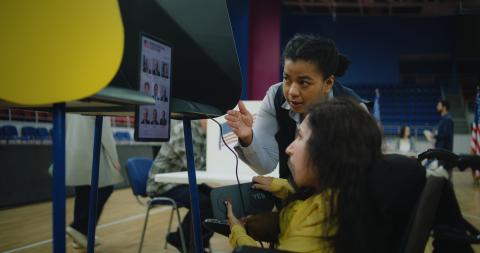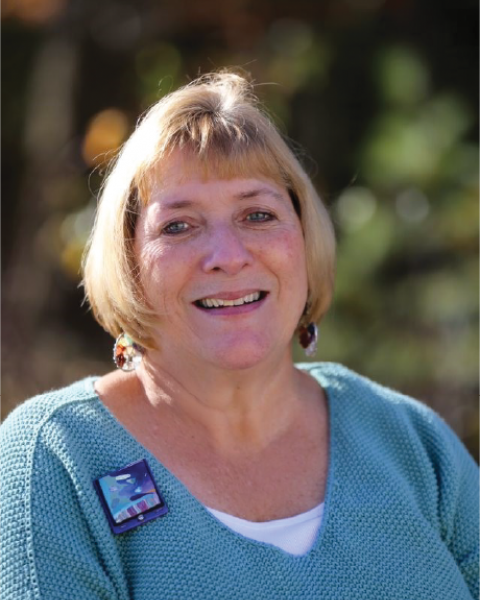A Full and Equal Opportunity: Vote 2024
"Not voting is not a protest, it's a surrender."
Keith Ellison, Attorney General of Minnesota

When I voted for the first time in September 1980, I knew I was missing the complete voting experience. The polls were not accessible to me as a wheelchair user, so I had no choice but to vote by absentee ballot. I was still excited. It felt like a rite of passage. It was official, my vote mattered, and I was an adult!
After college, I decided it was important to be visible while practicing my civil right to vote even if it wasn’t actually accessible. I wanted my community to recognize the barriers I had to deal with; for instance, I could not vote privately because accessible voting booths weren’t even considered then. I have only voted twice using an absentee ballot since 1980. It was rough at first, but the voting process has significantly improved since then. Title II of the Americans with Disabilities Act (ADA) involved making all public spaces accessible. The Help America Vote Act (HAVA) was passed in 2002 and focuses on the right of individuals to vote privately and independently in federal elections. These two civil rights laws are designed to give people with disabilities full and equal opportunities to vote.
The Disability Rights Center NH is a protection and advocacy agency that helps oversee New Hampshire’s voter access plan. Included in the plan are these rights:
- Voters with disabilities must be offered training about their rights and the voting process.
- Polling locations, parking, and entrances must be accessible.
- Anyone can register on the same day they vote.
- Election officials, poll workers, and volunteers must be trained to ensure access for disabled voters.
- We can use an accessible voting booth to vote privately and independently.
- Voters can have help from a friend, family member, or poll worker, but that person cannot try to influence their vote.
- If anyone makes a mistake on their ballot, they can get another one.
- New Hampshire rarely restricts voting rights.
Although many improvements have been made to make the voting process more accessible for everyone, voters with disabilities still face some challenges. I asked James Ziegra, a Staff Attorney from DRCNH, what barriers disabled voters are concerned with.
He said, ”Most poll workers do a pretty good job, but there were a few complaints about some poll workers and election officials who didn’t seem to be well-trained on how to set up and correctly use the one4all machine.”
HAVA requires that each polling place have at least one accessible voting system. It’s a tablet attached to a printer. The voter uses headphones to ensure their privacy. They can use a keyboard with bright yellow keys, or a touch screen to fill in their ballot. An election official provides the voter with a 3-digit code and instructs the voter on how it works. Some voters told him poll workers didn’t know where to find the 3-digit code to activate the system. James explained that the system has an instructional video and booklet for poll workers to assist with setup.
Recently, improvements have been made, the printed ballot now looks the same as any other. Using this system is important. It illustrates the need for everyone to be able to vote independently and privately. It is our constitutional right. The one4all system can be used by anyone. However, the system is still inaccessible if poll workers are not properly trained.
Every time I go to vote at my polling place, one of the workers says “Oh hi Kathy. We have YOUR machine ready.” I smile and politely say, “Oh the machine is called the one4all and it is there for anyone who wants to use it. Thank you for having it set up.”
The one4all voting system can be useful for voters with a wide range of disabilities. It is our responsibility to ask to use it. We can help by learning about this system and sharing the information with others.
Here are some voting stats to consider. This data is from the federal government’s Current Population Survey Voting Supplement for November 2022.
- Turnout has increased across all disability types and population groups, especially among young voters with disabilities.
- Between 2018 and 2022, states that provided easier access to voting by mail had significantly higher turnout among people with disabilities.
- 15.8 million citizens with disabilities reported voting in the November 2022 elections. However, a post-election survey found that 14% (2.2 million) voters with disabilities had some difficulty voting.
- If people with disabilities voted at the same rate as people without disabilities, there would be about two million more voters.
From Where I Sit…
We, the disability community, have the power to change the course of elections by speaking with the candidates and voting. If we are saying our vote does not matter, then we are saying we don't matter! Disability eventually touches every segment of the population, so disability issues are community issues. Issues like accessible housing, public transportation, more accessible and inclusive community infrastructure, and developing direct support career options with livable wages. We don’t just vote to make our own lives better. We vote to make our communities better for everyone.
